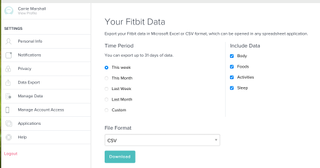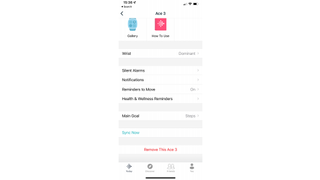With the market for the best fitness trackers moving so fast, there is an endless stream of new models with new sensors, new features, and new designs. And since fitness tracking is pretty addicting and makes you want to keep track of even more things, it means that sooner or later you will want to replace what you have. Whether you’ve been lured by the Fitbit Luxe, want a Huawei Band 3 Pro, or love the idea of an Oura (Generation 3), selling your existing fitness tracker can help pay for your upgrade.
So how do you do it Let’s find out.
1. Export your data
This doesn’t apply to every device (for example, if you sell a fitness tracker that syncs with your phone’s Health app, you can skip this step), but if your tracker doesn’t share this, many manufacturers allow you to track your fitness data so you can import them into another app, which is useful when you switch brands.
In this example we are using our Fitbit. To export your data, you need to log into your account on Fitbit.com and then go to Settings> Profile. If you look down on the left side of the page you should see an option to export data. Click on it and you can now set the start and end date and choose between Excel or CSV format.
With the Fitbit app you can export your data in CSV or Excel format (Image credit: Fitbit)
2. Remove it from your account
Many fitness trackers are linked to an online account, so the next step is to unlink them. Let’s use Fitbit again as an example: to remove a tracker from your account, go to the Fitbit app, tap Today, then tap the Settings icon; It’s the one that looks like a gear at the very top left of the screen. You should now see your device. Tap on it, scroll down and choose Remove This.
If your fitness tracker is a smartwatch such as an Apple Watch, you will need to disconnect (Apple) or reset (Google) it from your iCloud account. This is how it works on a Samsung Galaxy watch and this is how it works on an Apple Watch.
Disconnect your fitness tracker from your account before selling it (Image credit: Fitbit)
3. Reset to factory settings
Don’t do this until you are absolutely sure that you have exported all of the data you don’t want to lose, because this is the nuclear option: it will remove everything from your fitness tracker except for any software updates you may have installed to have. reset to brand new condition.
To factory reset the Fitbit Versa 3, you’ll need to go to the Settings app, scroll down to About Versa 3 and tap on it. Scroll down and you will see an option labeled Factory Reset. Tap on it to erase all the data on your tracker.
It’s similar with a Garmin Vivosmart 4: go to the settings menu, tap the information icon (‘i’), tap reset, then tap wipe data and reset settings. Don’t use the first option, Reset Defaults, as all of your data will remain on the device.
The process is slightly different on simpler devices, so for example on a Garmin Vivofit Jr 3 you have to go to Settings> General Management> Device Reset; on a Huawei Band 4 Pro you have to swipe to More> System> Reset; and on a Huawei Band 3e, tap the time screen four times with a knuckle and then tap the touch button until you see Reset. Or you can just use the Health app and go to Devices> Restore Factory Settings.
4. Decide where you want to sell it
Lots of sites will be happy to buy your fitness tracker, but you may not be happy with the price: we’re currently looking for a site that sells a massive £ 2 (that’s around $ 3 / AU $ 4) for a Fitbit Ace 2 and £ 10 (about $ 14 / AU $ 20) for a Fitbit Versa. That £ 10 for perfect condition; If it doesn’t look perfect, or doesn’t include the charger or bracelet, the price drops to £ 4 (about $ 6 / AU $ 8).
Be very careful when looking at equipment buying sites: we have had experience of phone trade-in sites where the site offered a brilliant price on our device in perfect working order and then emailed us stories about not existing damage and a. sent massively reduced offer. There are a lot of reputable sites out there, but there are also some opportunities. Do some research and trust your gut feeling too: if a given price seems too good to be true, it probably is too.
CEX is refreshingly transparent about how much it pays and how much it will sell the device, and this information can also help you decide what a fair price for your tracker would be if you sold it on Gumtree, that for free is. Facebook Marketplace, which is free and often very strange, or eBay, which charges a very small fee for successful sales.
It’s interesting to compare eBay prices with prices on gadget buying sites. For example, if you are in the UK, CEX will give you £ 28 cash or £ 40 coupon for a Fitbit Charge 4 and sell it for £ 60; the common price (at the time of writing) for a used Charge 4 on eBay is anywhere from £ 51 to £ 63. But of course these prices are not guaranteed. So while you might make more selling your used tracker on eBay, it might not. So here you have to go a little dirty Harry (or Harriet) and ask yourself a question: do you feel happy?
5. Submit it and deposit the money
For higher value items, it is wise to use track and trace shipments, especially eBay sales: some scammers pretend devices have not been received because they know eBay will find in their favor with no evidence. If you use a website to buy gadgets, they should have their terms and conditions set up. So follow the packaging instructions and don’t be afraid to track the payment if it doesn’t arrive at the promised time.
This is our favorite piece. Not sure which is the best? Here is our guide to the best fitness trackers you can buy today.
This article is part of TechRadar’s Get Fit in 2022 series – a collection of ideas and guides to help you get your health goals on the right track for the New Year regardless of your current fitness level.



